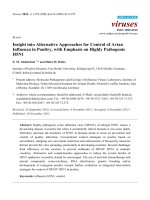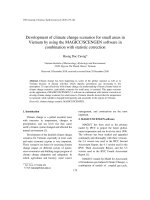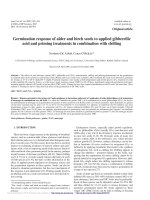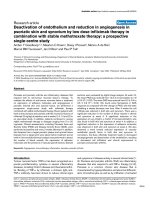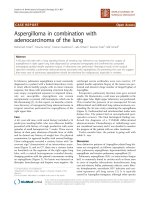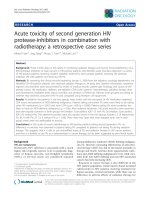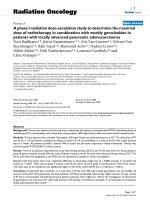Effect of biofertilizers in combination with inorganics on quality characters of carrot
Bạn đang xem bản rút gọn của tài liệu. Xem và tải ngay bản đầy đủ của tài liệu tại đây (288.5 KB, 7 trang )
Int.J.Curr.Microbiol.App.Sci (2019) 8(1): 2698-2704
International Journal of Current Microbiology and Applied Sciences
ISSN: 2319-7706 Volume 8 Number 01 (2019)
Journal homepage:
Original Research Article
/>
Effect of Biofertilizers in Combination with Inorganics on Quality
Characters of Carrot
P. Roshni1*, Narasimha Murthy2, K. Uma Jyothi1 and D.R. Salomi Suneetha1
1
College of Horticulture, Venkataramannagudem, Dr.Y.S.R.HU, A.P., India
Horticultural Research Station, Pandirimamidi, Dr.Y.S.R.HU, A.P., India
2
*Corresponding author
ABSTRACT
Keywords
Carrot,
Biofertilizers,
Inorganics, Quality
Article Info
Accepted:
17 December 2018
Available Online:
10 January 2019
The investigation was carried out at the Horticultural Research Station, Dr. Y. S. R.
Horticultural University, Andhra Pradesh during Rabi 2017-18 to study the effect of
bioinoculants and inorganics on quality characters of carrot. Two factors were taken, the
first factor being the chemical fertilizers at three levels (100%, 75%, 50% of RDF) and the
second factor was the different combinations of five biofertilizers (PSB, KSB,
Azospirillum, Azotobacter, VAM).The experimental design adopted was the factorial RBD
with 12 treatment combinations. The results revealed that the individual effect of chemical
fertilizers at level 100% RDF (75:60:50 kg/ha) and biofertilizer’s level PSB+ KSB+
Azospirillum+ Azotobacter + VAM showed a significant difference in quality characters
compared to the other levels. The characters viz., total soluble solids (9.50 °Brix), βcarotene content (5.29 mg/100 g), total sugars (10.94 %), reducing sugars (6.23 %), nonreducing sugars (4.71 %) and total protein content (866.63 mg/100g) of carrot were
recorded the highest with the application of 100% RDF+PSB+ KSB+ Azospirillum+
Azotobacter+ VAM. The lowest core diameter (2.11 cm), a favourable character was
achieved with the application 50% RDF+ PSB+ KSB+Azotobacter. The end of shelf life
was treated, at a stage where 50 per cent of the stored roots become unfit for consumption
and the maximum shelf life (3 days) was obtained at lower levels of nutrient applications.
Hence, varying rate of nutrients application effect the quality attributes significantly. The
use of biofertilizers in combination with the chemical fertilizers would yield higher quality
produce and also aid in adding steps towards sustainable crop production, by conserving
the soil health.
Introduction
The production and marketing of vegetable
crops are undergoing continuous change
globally, due to growing demands of
consumers for safe and healthy vegetables.
Vegetables make up a major portion of the
diet in many parts of the world and play a
significant role in human nutrition, especially
as sources of vitamins (C, A, B₁, B₆, B₉, E),
minerals, dietary fibre and phytochemicals
(Dias, 2012). Quality can be defined as a
degree of excellence, a high standard or value
in terms of appearance and nutritional value.
2698
Int.J.Curr.Microbiol.App.Sci (2019) 8(1): 2698-2704
The general objectives for any growers is to
obtain good yield, uniformity of crop and
resistance to abiotic-biotic stress whereas, the
objectives for consumers are quality,
appearance, shelf life, taste and majorly the
nutritional value.
Quality in vegetable crops is often more
important than yield for consumers therefore,
for the growers to survive, cultivars must be
accepted by the market and hence forth meet
the demands of the consumers (Silva, 2014).
Human and environmental health risks are
invited by inappropriate vegetable production
practices that arise with the judicial
application of nutrients to plants without due
regard to the pollution on air, soil or water.
The application of unsorted, excessive or
insufficient dose of nutrients to plants
negatively affects the quality attributes of the
crop (Dias, 2011).
Consumers are prepared to pay a premium for
such produce if their expectations are met and
even the processing sector, other industries
prefer vegetables with high TSS, sugars
ascorbic acid etc for the varied purposes. A
sustainable agriculture today makes a
sustainable
tomorrow.
The
different
combinations of recommended dose of
fertilizers along with the biofertilizers would
furnish the immediate requirements and also
supply the immobile and the fixed forms of
the nutrients thereby improve the various
quality traits of the crop. The experiment was
conducted with the objective to find the effect
of biofertilizers, NPK and the interaction
effect of biofertilizers and different levels of
NPK on quality characters of carrot.
Materials and Methods
Field experiment was conducted at
Horticultural Research Station, Pandirimamidi
that comes under high altitude tribal zone of
Andhra Pradesh, India which is situated at an
altitude of 250 m above mean sea level with
17°25' East latitude and 81°45' North
longitudes. The experimental site received an
annual rainfall of 1186 mm. The pH of
irrigation water was recorded as 6.0 and EC
was 1.66dSm-1. The land used under the
experiment was fairly uniform with pH of 6.5.
The experiment consisted of twelve treatment
combinations with three levels of inorganics
(100% RDF (F₁)- 75:60:50 kg/ha; 75% RDF
(F₂)- 56:45:37.5 kg/ha and 50% RDF (F₃)37.5:30:25 kg/ha) and four levels of
biofertilizers (PSB+ KSB+ Azospirillum (B₁),
PSB+ KSB+ Azotobacter (B₂), PSB+ KSB+
Vesicular Arbuscular Michorrhiza (B₃), PSB+
KSB+ Azospirillum+ Azotobacter + VAM
(B₄)). The factorial randomized block design
was adopted with three replications. The
experimental field was thoroughly ploughed to
a depth of 30 cm and harrowed twice. The
field was laid at a gross plot size of 2.2 m X
1.8 m and net plot size of 2 m X 1.5 m. The
biofertilizers (PSB, KSB, Azospirillum,
Azotobacter, VAM) were applied to soil, by
adding them to well decomposed FYM as per
different treatments at the rate of 5 kg/ ha. The
field was irrigated and let for the beneficial
microorganisms to grow. Carrot seed cv. Pusa
Rudhira was sown in ridge and furrow system
at a depth of 1 cm. Standard cultural and
management
practices
were
adopted.
Observations were recorded on various quality
traits viz., total soluble solids, β-carotene
content, total sugars, reducing sugars, nonreducing sugars and total protein content of
carrot. The end of shelf life was treated, at a
stage where 50 per cent of the stored roots
become unfit for consumption. The data
collected was subjected to analysis of variance
(ANOVA). The test of significance (t-test) and
critical difference was calculated at 0.05%
probability.
Results and Discussion
The results obtained highlight the importance
of the significant variation within the various
levels of inorganics and biofertilizers, singly
2699
Int.J.Curr.Microbiol.App.Sci (2019) 8(1): 2698-2704
and also in combinations. The TSS of carrot
recorded highest (8.84 °B) in the plants
applied with 100% RDF (F1) followed by 75%
RDF (F2) and 50% RDF (F3) with 8.50 °B and
7.99 °B respectively. Biofertilizers PSB+
KSB+ Azospirillum+ Azotobacter+ VAM
(B4) recorded the highest (8.94 °B) TSS,
followed by PSB+ KSB+ Azotobacter (B2)
with 8.42 °B and PSB+ KSB+ VAM (B3) with
8.32 °B were found to be on par with each
other.
The crop applied with 100% RDF+ PSB+
KSB+ Azospirillum+ Azotobacter +VAM
(F1B4) combination reported the maximum
interaction effect and recorded highest TSS of
9.50 °B followed by 100% RDF+ PSB+
KSB+ Azotobacter (F1B2) with 8.80 °B.
The increasing K fertilizer played a key role in
increasing the root TSS value. The higher
dosage of nutrients provided to the crop
hastens the metabolic activity in the shoot and
the accumulation of photosynthates there by
accumulation
of
various
forms
of
carbohydrates i.e. sugars (predominantly
sucrose). The findings are in agreement with
Lyngdoh (2001) in carrot. It was suggested
that, this could be due to the improvement of
soil structure and improved nutrient and
moisture status of the soil in favour of plant
growth due to application of bio fertilizers.
Higher core diameter is considered as an
unfavourable character. It was observed that
the different levels of chemical fertilizers,
biofertilizers and also the interaction of both
the factors at various levels had no significant
effect on core diameter of the roots. However,
at lower levels of chemical fertilizers and
biofertilizers, the lowest root diameter was
recorded, which ultimately resulted in a lower
core diameter.
The nutrition plays an important role for βcarotene content and protein accumulation in
the roots. The β-carotene and protein content
increased with increasing levels of chemical
fertilizers and recorded the highest of 5.06
mg/100g and 823.47 mg/100 g respectively
with the treatment of 100% RDF (F1),
followed by 75% RDF (F2) and 50% RDF (F3)
(Table 1). Similarly, biofertilizers PSB+
KSB+ Azospirillum+ Azotobacter+ VAM (B4)
recorded the highest β-carotene content of
5.05 mg/100 g and protein 828.40 mg/100 g
followed by the application of PSB+ KSB+
Azotobacter (B2) with 4.68 mg/100 g and
808.02 mg/100 g respectively. The lowest
values in trems of β -carotene and protein
content were recorded with PSB+ KSB+
Azospirillum (B1) application (Table 1).
It was observed that within the interaction
effects
100%
RDF+
PSB+
KSB+
Azospirillum+ Azotobacter+ VAM (F1B4)
recorded the highest β -carotene and protein
contents 5.29 mg/100g and 866.68 mg/100 g
respectively, followed by 100% RDF+ PSB+
KSB+ Azotobacter (F1B2) while the lowest
values were recorded in the combination of
50% RDF+ PSB+ KSB+ Azospirillum (F3B1)
in both the parameters (Table 2).
The higher photosynthates accumulation and
metabolism in the plant coupled with rapid
cell division might be the reason for the
highest dose of chemical fertilizers showing
relative effect on the biosynthesis of
antioxidant compounds, pigments in the plant.
This would be due to specific soil nutrients
which might have been more readily available
for shoot absorption, as a result of mineral and
biofertilizers integration, which activated
specific enzymes for the synthesis of carotene
in carrot. The results obtained were in
accordance with Sanwal et al., (2006) in
broccoli and Vithwel and Kanaujia (2013) in
carrot. Nitrogen is a fundamental component
of amino acids, which are the molecular
building blocks of protein.
2700
Int.J.Curr.Microbiol.App.Sci (2019) 8(1): 2698-2704
Table.1 Quality characters as effected by the different chemical fertilizers and biofertilizers
Treatments
Total
soluble
solids
(°Brix)
Core
β–Carotene
diameter (mg/100 g)
(cm)
Total
protein
(mg/100
g)
Total
sugars
(%)
Reducing
sugars
(%)
Nonreducing
sugars
(%)
Shelf life
(days)
Chemical fertilizers
100% RDF (F1)
8.84
2.57
5.06
823.47
18.16
13.50
11.13
2.66
75% RDF (F2)
8.50
2.50
4.49
803.55
17.09
13.23
10.44
2.58
50% RDF (F3)
C.D. at 5%
SE(m) +
Biofertilizers
PSB+ KSB+ Azospirillum (B1)
PSB+ KSB+ Azotobacter (B2)
PSB+ KSB+ VAM (B3 )
PSB+KSB+Azospirillum+Azotobacter
+ VAM (B4)
C.D. at 5%
SE(m) +
7.99
0.09
0.03
2.36
N/S
-
4.21
0.17
0.05
701.71
9.69
3.28
16.32
0.55
0.18
12.18
0.74
0.25
10.20
1.05
0.35
2.58
N/S
-
8.09
8.42
8.32
8.94
2.42
2.39
2.54
2.57
4.16
4.68
4.45
5.05
704.02
808.02
764.53
828.40
15.71
17.59
16.96
18.50
12.15
13.16
12.66
13.91
9.23
11.22
9.87
12.04
2.55
2.66
2.77
2.44
0.11
0.03
N/S
-
0.19
0.06
11.19
3.79
0.63
0.21
0.85
0.29
1.21
0.41
N/S
-
NOTE: The values for the total, reducing and non-reducing sugars are transformed values, as for percentages angular transformation is followed.
2701
Int.J.Curr.Microbiol.App.Sci (2019) 8(1): 2698-2704
Table.2 Quality characters as affected by different combinations of chemical fertilizers and biofertilizers
Treatment combinations
2.35
β–
Carotene
(mg/100
g)
4.66
Total
protein
(mg/100
g)
750.07
100% RDF+ PSB+ KSB+ Azospirillum
(F1B1)
Total
soluble
solids
(°Brix)
8.35
100% RDF+ PSB+ KSB+ Azotobacter
(F1B2)
8.80
2.64
5.18
852.88
100% RDF+ PSB+ KSB+ VAM
(F1B3)
8.72
2.62
5.12
824.23
9.50
2.69
5.29
866.68
8.25
2.57
4.11
766.27
100%RDF+PSB+KSB+Azospirillum+ Azotobacter +
VAM
(F1B₄)
75% RDF+ PSB+ KSB+ Azospirillum
(F2B1)
Core
diameter
(cm)
75% RDF+ PSB+ KSB+ Azotobacter
(F2B2)
8.54
2.43
4.56
805.06
75% RDF+ PSB+ KSB+ VAM
(F2B3)
8.46
2.33
4.11
795.87
8.76
2.11
5.17
847.01
7.69
2.41
3.71
595.73
75%RDF+PSB+KSB+Azospirillum+ Azotobacter +
VAM
(F2B₄)
50% RDF+ PSB+ KSB+ Azospirillum (F3B1)
50% RDF+ PSB+ KSB+ Azotobacter
(F3B2)
7.93
2.58
4.30
766.13
50% RDF+ PSB+ KSB+ VAM
(F3B3)
7.80
2.41
4.13
673.48
8.56
2.58
4.70
771.50
0.19
0.06
N/S
-
0.34
0.11
19.38
6.56
50%RDF+PSB+KSB+Azospirillum+ Azotobacter +
VAM
(F3 B₄)
C.D. at 5%
SE(m) +
Total
sugars
(%)
Reducing
sugars (%)
8.53
(16.97)
10.02
(18.43)
9.51
(17.95)
10.94
(19.29)
7.25
(15.61)
9.03
(17.46)
8.61
(17.05)
9.81
(18.24)
6.33
(14.56)
8.45
(16.87)
7.51
(15.87)
9.53
(17.97)
0.92
0.37
4.8
(12.60)
5.81
(13.94)
5.32
(13.03)
6.23
(14.44)
4.86
(12.72)
5.32
(13.29)
5.04
(12.96)
5.81
(13.94)
3.78
(11.13)
4.51
(12.25)
4.36
(11.99)
5.35
(13.36)
1.31
0.50
NOTE: The values in the brackets are transformed values, as for percentages angular transformation is followed
2702
Nonreducing
sugars
(%)
3.73
(9.91)
4.21
(11.46)
4.39
(10.23)
4.71
(12.91)
2.54
(9.04)
3.71
(10.81)
3.56
(10.45)
3.99
(11.47)
2.38
(8.75)
3.94
(11.38)
3.15
(8.93)
4.18
(11.73)
1.91
0.71
Shelf life
(days)
3.0
2.66
2.66
2.33
2.33
3.00
2.66
2.33
2.33
2.33
3.00
2.66
N/S
-
Int.J.Curr.Microbiol.App.Sci (2019) 8(1): 2698-2704
Therefore, increase in nitrogen based inputs,
through the increasing levels of inorganics
and biofertilizers would have triggered the
protein accumulation. The use of biofertilizers
improved the nitrogen availability for the
plants by binding the atmospheric nitrogen
and thus, improving the bioactive molecules
in the roots.
reducing sugar (14.44%), non-reducing sugars
(12.91%) in the plants applied with 100%
RDF+
PSB+
KSB+
Azospirillum+
Azotobacter+ VAM (F1B4) followed by 100%
RDF+ PSB+ KSB+ Azotobacter (F1B2) while,
the lowest values were recorded with
combination of 50% RDF+ PSB+ KSB+
Azospirillum (F3B1) (Table 2).
The results obtained were in line with Solanki
et al., (2010) in brinjal and with Singh et al.,
(2014) in broccoli who reported that the
combination of biofertilizers along with
chemical fertilizers recorded a high protein
and lipid profile along with phosphate and
sulphate content of broccoli curds.
Total sugars are the sum of reducing and nonreducing sugars, a similar trend of response
was observed to be followed as in the case all
the sugars. The nutrients applied increased the
shoot
growth
and
photosynthetic
accumulation this might have increased the
sugar content in the roots as a fact that
fertilizers play a key role in effective
development of the plants, as each mineral
nutrient has a specific role in running a
dynamic system in the plants which yield
various quality and quantity related characters
in the plants’ internal processes. Solanki et
al., (2010) also obtained similar results with
regard to sugars in brinjal crop.
The sugar’s content increased linearly with
the increasing fertilizer levels. The highest
total sugars (18.16%), reducing sugars
(13.50%) and non-reducing sugars (11.13%)
with 100% RDF (F1) followed by 75% RDF
(F2) and 50% RDF (F3) (Table 1).
Among the various biofertilizers the
application of PSB+ KSB+ Azospirillum +
Azotobacter+ VAM (B4) recorded the highest
total sugar (18.50%), reducing sugar
(14.44%) and non- reducing sugars (12.04%)
followed by PSB+ KSB+ Azotobacter (B2)
and PSB+ KSB+ VAM (B3) (Table 1). Within
the total sugars PSB+ KSB+ Azotobacter (B2)
recorded 17.59% and was on par with PSB+
KSB+ VAM (B3) with 16.96%. The results
with regard to non-reducing sugars showed,
that the treatment of biofertilizers PSB+
KSB+ Azospirillum+ Azotobacter+ VAM
(B4) was on par with PSB+ KSB+
Azotobacter (B2) with 11.22%. The lowest
total sugars (15.71%), reducing sugar
(11.13%) and non-reducing sugars (9.23%)
were recorded with the treatment of PSB+
KSB+ Azospirillum (B1). The treatment
combinations at various levels of chemical
fertilizers and biofertilizers recorded the
highest values of total sugars (19.29%),
The presence of PSB, KSB and VAM would
have increased the availability of nutrients by
forming symbiotic associations with the
plants and increasing the surface of
absorbtion along with mobilising the
nutrients. Abdelaal and Sahar (2015) also
obtained similar results with regard to the
application of biofertilizers which improves
the efficiency of the nutrient uptake and aids
in the storage of sugars after photosynthesis in
sugar beet.
The different levels of chemical fertilizers,
biofertilizers and the interaction had no
significant influence on the shelf life of the
carrot roots. The roots were found to lose
their edible quality when kept under room
temperature within an average of 2-3 days.
The quality of vegetables deteriorates
gradually during storage in response to
endogenous factors and environmental
2703
Int.J.Curr.Microbiol.App.Sci (2019) 8(1): 2698-2704
conditions. Processes such as transpiration,
respiration, activation of growth and attack by
pathogens lead not only to quantitative losses
but quality losses, which can destroy the
marketability of the product (Sable and
Bhamare, 2007).
With the results from the present experiment
it can be concluded that the best quality
carrots can be obtained with the application of
100% RDF+ PSB+ KSB+ Azospirillum+
Azotobacter+ VAM. As, the complete dose of
fertilizers would add in the crops the
immediate source of nutrition for the
metabolisms to show appropriate growth and
the biofertilizers would supply the required
nutrients throughout the season in a
sustainable manner and available form by
maintaining the soil health.
References
Abdelaal, K. A. A. and Sahar, F. T. 2015.
Response of sugar beet plant (Beta
vulgaris L.) to mineral nitrogen
fertilization
and
biofertilizers.
International
journal
Current
Microbiology Applied Science. 4(9):
677-88.
Dias, J.S. 2012. Major classes of
phytonutriceuticals in vegetables and
health benefits: A review. Journal of
Nutritional Therapeutics, 1, 31-62.
Dias, J.S. and Ryder, E.J. 2011. World
Vegetable Indus- try: Production,
breeding,
trends.
Horticultural
Reviews, 38, 299-356.
Lyngdoh, G. B. S. 2001. Response of carrot to
different
levels
of
nitrogen,
phosphorus
and
potassium.
Horticultural Journal. 14 (2):163-69.
Sable, P. B. and Bhamare, V. K. 2007. Effect
of biofertilizers (Azotobacter and
Azospirillum)
alone
and
in
combination with reduced levels of
nitrogen on quality of cauliflower cv.
Snowball – 16.The Asian Journal of
Horticulture. 2 (1): 215-17.
Sanwal, S. K. Laxminarayana, K. Yadav, D. S.
Rai, N. and Yadav, R. K. 2006.
Growth,
yield,
and
dietary
antioxidants of broccoli. Periodica
Polytechnica Ser. Chem. Eng. 36(1):
25-41.
Silva J. C. 2014. Guiding strategies for
breeding
vegetable
cultivars.
Agricultural Sciences. 5, 9-32.
Singh, S. Maji, and Kumar. 2014. Effect of
biofertilizers on yield and biomolecules of anti-cancerous vegetable
broccoli. International Journal of Bioresource and Stress Management.
5(2): 256- 62.
Solanki, M. P. Patel, B. N. Tandel, Y. N. and
Patel, N. B. 2010. Growth, yield and
quality of brinjal as affected by use of
bio-fertilizers. The Asian Journal of
Horticulture. 5 (2): 403- 06.
Vithwel and Kanaujia, S. P. 2013. Integrated
nutrient management on productivity
of carrot and fertility of soil. SAARC
Journal of Agriculture. 11(2): 173- 81.
How to cite this article:
Roshni, P., Narasimha Murthy, K. Uma Jyothi and Salomi Suneetha, D.R. 2019. Effect of
Biofertilizers in Combination with Inorganics on Quality Characters of Carrot.
Int.J.Curr.Microbiol.App.Sci. 8(01): 2698-2704. doi: />
2704
